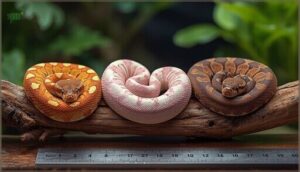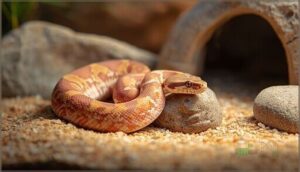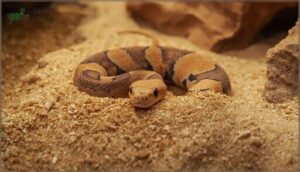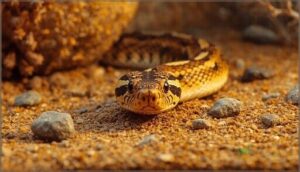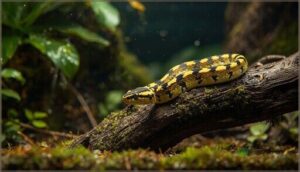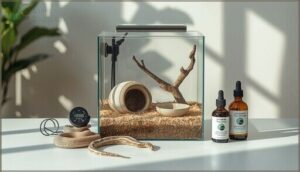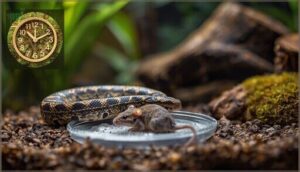This site is supported by our readers. We may earn a commission, at no cost to you, if you purchase through links.
Most “small” snakes aren’t actually small—they just start that way. A cute baby ball python grows to 4-5 feet, and what seemed manageable in a 20-gallon tank suddenly needs serious floor space.
But here’s the good news: several species genuinely stay compact throughout their entire lives, maxing out at 2-3 feet and thriving in modest enclosures. These pint-sized constrictors and colubrids offer the same fascinating behaviors as their larger cousins—hunting, exploring, even the occasional amusing escape attempt—without demanding a spare bedroom.
Whether you’re working with apartment constraints or simply prefer a snake you can handle confidently without recruiting backup, choosing a species that stays small isn’t settling for less. It’s selecting the right fit from the start.
Table Of Contents
- Key Takeaways
- Why Choose a Small Pet Snake?
- Key Traits of Snakes That Stay Small
- Top Small Pet Snake Species
- Comparing Small Snake Species
- Essential Care for Small Pet Snakes
- Diet and Feeding for Small Snakes
- Choosing The Best Small Snake for You
- Frequently Asked Questions (FAQs)
- What is the most cuddly pet snake?
- What small snake is a good pet?
- What pet snakes stay the smallest?
- What is the most low maintenance snake?
- What small snakes like to be handled?
- What is the smallest non poisonous snake in the world?
- How long do small pet snakes typically live?
- Are small snakes suitable for handling by children?
- Can small snakes be kept together in one enclosure?
- What are the best small snakes for apartments?
- Conclusion
Key Takeaways
- Small pet snakes like Kenyan sand boas (12-20 inches), rosy boas (24-36 inches), and ringneck snakes (under 15 inches) genuinely stay compact their entire lives, thriving in 10-30 gallon enclosures without ever demanding apartment-sized spaces.
- These pint-sized species cost under $20 monthly to feed with frozen mice every 5-14 days, use minimal heating equipment, and require far less startup investment than their larger cousins—making them budget-friendly without sacrificing the full snake-keeping experience.
- Corn snakes and ball pythons top the beginner-friendly list because they tolerate handling mistakes, rarely refuse food, and stay calm during interaction, while species like Kenyan sand boas need almost zero handling and thrive with basic dry setups.
- Choosing a small snake means committing to 15-30 years of care (ball pythons and rosy boas often hit 30), so you’ll need upfront legal research, a reptile vet located before emergencies, and honest assessment of whether you can budget decades of enclosure upgrades and veterinary costs.
Why Choose a Small Pet Snake?
You might think all snakes need massive glass enclosures and a side of beef every week, but that’s really not the case. Small pet snakes break the mold—they’re budget-friendly, space-efficient, and way less intimidating for first-time owners.
Here’s exactly why downsizing your snake dreams might be the smartest move you’ll make.
Space-Saving Enclosure Requirements
Unlike their bigger cousins, small pet snakes thrive in compact enclosures—most species do perfectly well in a 30-gallon tank. That means you won’t sacrifice half your living room to reptile husbandry.
Proper enclosure design still matters, though: you’ll need solid ventilation systems and humidity control to keep your snake healthy. Think miniature habitats that fit on a desk, not sprawling terrariums.
When creating these habitats, consider the importance of methodological rigor in scientific studies to guarantee the best care for your pet.
Lower Feeding and Maintenance Costs
Small pet snakes deliver serious cost-effective feeding advantages—you’re looking at prey items like mice or small rats every 5–14 days, not daily banquets. That’s affordable substrates like aspen shavings, energy-efficient heating with simple under-tank pads, and low-maintenance care that won’t drain your wallet.
Here’s what makes small enclosure savings real:
- Monthly feeding bills stay under $20 for most species
- Compact tanks mean cheaper startup costs and replacements
- Frozen-thawed prey reduces waste and handling risks
- Routine cleaning supplies cost pennies per week
Easier Handling for Beginners
Beyond budget perks, you’ll appreciate how small pet snakes simplify beginner safety and snake handling. Their compact size means gentle support comes naturally—no wrestling 6-foot boas. Calm environments and short handling sessions reduce stress for both you and your snake, building confidence fast.
Most small pet snake breeds tolerate routine interaction without thrashing, making reptile pet care less intimidating and genuinely rewarding.
Attractive Colors and Patterns
Once you’ve mastered handling, you’ll notice another perk—these small pet snake breeds are living artwork. Color morphs range from jet-black melanistic beauties to glowing albino gems, while pattern genetics reveal endless breed variations. Whether you prefer bold banding or subtle blotches, visual appeal stays high. Snake camouflage in naturalistic setups adds intrigue, and each pet snake species offers unique combinations you won’t find in larger constrictors.
- Albino morphs glow under daylight—perfect for showing off your new companion
- Hypomelanistic variants soften edges—gentle pastels that feel calming to observe
- Banded patterns shift with age—your snake’s look evolves, keeping ownership exciting
Key Traits of Snakes That Stay Small
Not all small snakes are created equal—and knowing what sets them apart will help you pick the right one. Some species max out at 18 inches, while others creep closer to 4 feet, so “small” means different things depending on who you ask.
Let’s break down the key traits that define snakes that stay compact, from their adult size to their knack for squeezing through impossibly tiny gaps.
Average Adult Sizes
When you’re shopping for small pet snakes, knowing exactly how big they’ll get matters—a lot. Ball pythons usually max out around 4 to 5 feet in captivity, while corn snakes hit similar lengths. Rosy boas stay compact at 2.5 to 3.5 feet, and Kenyan sand boas rarely push past 20 inches. Size variance between individuals happens, but these snake species remain genuinely manageable for years.
Temperament and Handling
Most small pet snakes tolerate regular handling surprisingly well—especially when you start gently and build their confidence over time. Snake behavior varies by individual, but consistent, calm interaction teaches your pet that you’re not a threat, reducing defensive reactions and stress.
Gentle handling essentials for small pet snakes:
- Support the entire body during reptile care to prevent discomfort or injury
- Keep sessions short—10 to 15 minutes max—then return your snake to its enclosure
- Watch for stress signals like hissing, rigid coiling, or a flattened body
- Wash hands before and after snake handling to minimize odor cues
Ball pythons and corn snakes usually adapt well to routine interaction, whereas rosy boas and Kenyan sand boas prefer softer, less frequent handling (grab from the side, never from above). Western hognose snakes can become defensive without early socialization, and garter snakes vary widely—some remain calm, while others get nippy, especially when cool. Handling tips like these make temperament tests easier and help you identify stress early.
Avoid picking up your snake right after feeding—that’s a fast track to regurgitation and unnecessary stress. Over-handling wears them down too, so balance interaction with plenty of alone time. When you respect their signals and pace yourself, you’ll observe stable feeding patterns, smooth sheds, and a snake that’s genuinely comfortable around you. That’s stress management done right.
Lifespan and Long-Term Commitment
Generally, small snakes live 6 to 20 years—sometimes longer with diligent reptile care. Ball pythons often hit 20 to 30 years, while corn snakes reach 15 to 20 under solid snake care routines. Rosy boas and Kenyan sand boas can surpass 20 years too.
Long-term care means planning for decades of commitment, yearly vet visits, stable temps, and proper nutrition as your pet snakes age—health issues included.
Escape Artist Tendencies
Snakes can squeeze through gaps you’d never expect—even a tiny crack becomes an exit route. Most small snakes employ rapid lateral movement or tight coiling when stressed, so secure enclosure setup and design matters.
Lock those lids, eliminate substrate gaps, and add multiple hides to cut down escape attempts. Regular snake handling also calms them, reducing exploratory behaviors during routine pet snakes maintenance.
Top Small Pet Snake Species
Now that you know what makes a snake “stay small,” let’s look at the eight species that fit the bill perfectly. Each one brings something different to the table—whether it’s striking colors, unusual behavior, or beginner-friendly care requirements.
Here’s your lineup of compact companions, complete with what makes each one worth considering.
Rosy Boa
If you’re looking for a compact companion that won’t outgrow your setup, the rosy boa checks every box. This gorgeous snake averages 24 to 36 inches—perfect for a 20-gallon terrarium—and brings calm, easygoing energy to every handling session. Here’s why rosy boa care is beginner-friendly:
- Docile temperament makes pet boa handling stress-free, even for first-timers
- Simple diet of frozen rodents covers boa feeding tips without fuss
- Minimal snake habitat design needs—basic heat gradient and hiding spots suffice
Kenyan Sand Boa
Want a snake that practically lives underground? The Kenyan sand boa tops the list of small pet snakes—adults hit just 12 to 14 inches and spend most of their time burrowed in substrate.
Your habitat creation focuses on deep bedding, a warm hide, and minimal décor.
Sand boa diet centers on frozen pinky mice every 10 days, while their low activity sidesteps most boa health issues and makes snake handling tips almost unnecessary.
Western Hognose Snake
If you’ve moved past a burrower, the Western hognose snake brings personality to your collection—adults usually reach 24 to 36 inches and sport that iconic upturned snout. Hognose care centers on sandy substrate, a basking zone around 90°F, and toad-scented prey (frozen mice work fine). Western hognose behavior includes dramatic “death feigning,” making this pet snake species entertaining for any beginner’s guide to pet snakes journey.
- That upturned snout isn’t just adorable—it’s built for digging through loose Western habitat substrates you’ll recreate at home.
- Snake morphs explode with hognose varieties—albino, axanthic, and conda patterns let you pick a one-of-a-kind companion.
- You’re in control of hognose diet from day one—no wild toad hunting means straightforward reptile care with frozen rodents.
- Their bluff strikes rarely connect—even defensive posturing feels safe, giving you confidence during snake care and maintenance routines.
- Watching a hognose “play dead” never gets old—flipping belly-up with an open mouth is pure theater in your living room.
Ball Python
Beyond theatrics, the ball python delivers real substance—adults usually hit 3 to 4 feet, and their reputation as reptile pets for beginners isn’t hype. Snake behavior stays docile, feeding techniques remain straightforward with frozen rodents, and pet snake care feels manageable. This beginners guide to pet snakes favorite earns its popularity through snake care and maintenance simplicity—no drama required.
Ball python morphs explode in variety, from piebald to pastel, so you control your python habitat aesthetic.
Corn Snake
If you’re ready to step up—corn snakes grow 4 to 5 feet but stay beginner-friendly. Corn Snake Care shines: hardy appetites, docile Snake Behavior, and jaw-dropping morphs (albino, bloodred, you name it).
Their Snake Habitat needs mirror other Small Pet Snakes, Feeding Tips stay simple with frozen mice, and Reptile Care feels forgiving.
Perfect for confident newcomers craving Pet Snake Care without the stress.
Ringneck Snake
Looking for even tinier? Ringneck snakes stay under 15 inches—perfect for Small Pet Snakes enthusiasts craving micro Reptile Pets for Beginners. Their Ringneck Habitat fits a 10-gallon tank, and Snake Behavior leans secretive (hello, burrowing!).
Feeding Techniques require tiny invertebrates like slugs or worms. Pet Care Tips and Handling Methods stay gentle since they’re delicate, making Pet Snake Care feel specialized yet rewarding for patient keepers.
Children’s Python
Despite the name, Children’s pythons aren’t just for kids—they’re small pet snakes maxing out around 3 feet, perfect for reptile pets for beginners. Their calm behavior and straightforward care make them an ideal choice for those new to snake ownership.
A 20-gallon habitat is sufficient for these snakes, and their diet is simple: frozen mice suit them fine. Snake health monitoring is easy due to their docile nature, though breeding methods require experience.
Garter Snake
Garter snakes bring a spark of energy to small pet snakes—they’re active, curious, and usually stay under 24 inches. Their lively snake behavior makes them fun to watch, though their wiggly nature means snake handling techniques require a gentle grip.
A garter snake habitat needs good ventilation and humidity control. Pet snake health stays strong with earthworms and small fish, making garter care tips straightforward for beginners exploring reptile care.
Comparing Small Snake Species
Now that you’ve met the top eight contenders, let’s put them side by side so you can see how they stack up.
Each snake brings something different to the table—whether it’s size, temperament, or care needs—and understanding these differences will help you pick the right match.
Here’s what sets these small species apart from each other.
Size Differences
Not all small pet snakes stay uniformly tiny—size variance among species can surprise you. Kenyan sand boas max out around 18 inches, while corn snakes commonly hit 4 to 5 feet despite being labeled “small.”
Growth rates differ too: ball pythons usually reach 3 to 4 feet, and rosy boas often stay under 3 feet, making adult lengths a key factor in small pet snake care planning.
Care Level for Beginners
You’ll find corn snakes top the chart for first-time reptile keeping tips—they tolerate minor husbandry mistakes and rarely refuse food. Ball pythons rank next as easy species for snake care beginners, staying calm during pet snake handling. Kenyan sand boas need minimal gear in small enclosures, making care basics simple.
Here’s a quick rundown of beginner tips:
- Corn snakes forgive temperature swings better than most small pet snakes.
- Ball pythons ball up instead of striking, easing snake handling anxiety.
- Kenyan sand boas thrive with dry substrate and basic hides—no complex setup required. For a secure vivarium, consider proper snake care to guarantee good health.
Activity and Temperament
You’ll notice ball pythons move slowly and tolerate handling without defensive strikes—perfect for learning pet snake handling. Corn snakes stay more curious, exploring your hands with quick movements that reflect their active patterns. Kenyan sand boas prefer burrowing over interaction, showing lower activity overall.
Here’s how snake behavior and characteristics compare:
| Species | Activity Patterns | Temperament Types |
|---|---|---|
| Ball Python | Crepuscular, calm | Docile, slow-moving |
| Corn Snake | Active, exploratory | Curious, moderate responsiveness |
| Rosy Boa | Low-moderate | Even-tempered, infrequent rapid movement |
| Kenyan Sand Boa | Sedentary | Prefers secure environment |
| Western Hognose | Moderate | May display bluffing behaviors |
Environmental influences like temperature gradients and handling techniques shape how small pet snakes respond—juveniles explore more, while adults settle into predictable routines.
Color and Pattern Variety
You’ll discover pet snakes showcase stunning color morphs—from banded milk snakes to blotched corn snakes, each species displays unique pattern genetics shaped by selective morph breeding.
Rosy boas often sport earth tones that mimic natural snake camouflage, while Kenyan sand boas exhibit high-contrast scales. Scale texture varies too, with some morphs appearing glossy and others matte, adding visual depth to your collection.
Essential Care for Small Pet Snakes
You’ve picked your snake—now it’s time to set up the right environment so your new pet actually thrives. Getting the enclosure, temperature, substrate, and handling routine dialed in from day one makes all the difference between a stressed snake and a healthy, curious companion.
Let’s break down exactly what your small snake needs to feel safe and stay strong.
Proper Enclosure Setup
Your snake’s home starts with the right reptile enclosure setup—aim for at least 1.5 times your pet’s length in floor space.
You’ll need:
- Secure latching lid to prevent escape artist antics
- Safe substrate like reptile carpet or paper towels
- Hiding spots on both warm and cool sides
Glass or plastic snake enclosures work great, and proper ventilation management keeps air fresh without drafts.
Temperature and Humidity Needs
Once your reptile enclosure setup is ready, temperature control and humidity levels take center stage. Most pet snake species need a warm side around 82–90°F and a cooler zone near 72–82°F—this gradient facilitates natural thermoregulation. Heat sources like ceramic emitters work well when paired with a thermostat. Environmental monitoring with thermometers and a hygrometer keeps your snake habitat stable and your reptile care on point.
| Parameter | Target Range |
|---|---|
| Warm side | 82–90°F |
| Cool side | 72–82°F |
| Humidity | 40–60% |
Substrate and Hiding Spots
After nailing temperature gradients and humidity control in your reptile enclosure, substrate depth and hiding spot placement deserve equal attention. Your snake habitat needs at least 2–3 inches of burrowing materials—aspen or hardwood mulch work great for most pet reptiles. Place two hiding spots on opposite ends to support thermoregulation. Here’s what makes snake enclosures work:
- Choose substrate that won’t cause respiratory irritation
- Provide caves on both warm and cool sides
- Verify hides fit snugly around your snake’s body
- Add removable-lid shelters for easy cleaning
- Monitor substrate moisture with a hygrometer
Deep substrate encourages natural behavior, and proper hiding spot placement reduces stress—your snake will thank you by staying calm during reptile and amphibian care routines.
Handling and Socialization
Once your snake feels secure in its habitat, you can start building trust through gentle touch. Support the entire body with both hands—never grab near the head—and keep sessions under 10 minutes daily. Wait 48 hours after feeding to avoid regurgitation.
Watch for stress signals like freezing or thrashing, then pause immediately. Consistent, calm handling turns skittish pet snakes into relaxed companions.
Diet and Feeding for Small Snakes
Getting the feeding routine right is one of the most straightforward parts of keeping small snakes—they’re not picky eaters, and most will happily accept frozen-thawed rodents. The key is matching prey size to your snake’s girth and sticking to a consistent schedule that keeps them healthy without overfeeding.
Let’s break down what you need to know about prey types, timing, and avoiding common mistakes.
Appropriate Prey Types and Sizes
Your snake’s meal should never be wider than the thickest part of its body—that’s the golden rule for prey size guidelines. Frozen-thawed prey is safer than live food and prevents bite injuries during snake feeding.
Start hatchlings on pinkie mice, then gradually increase size as they grow. Getting digestion issues? You’re probably offering meals that are too large for proper snake nutrition.
Feeding Frequency
Generally, you’ll feed adult small snakes every 1 to 2 weeks—younger snakes need meals every 5 to 7 days during their rapid growth phases. Consistent feeding schedules support reliable digestion and prevent regurgitation incidents.
As your snake matures, feeding frequency decreases naturally (some adults thrive on 10-to-14-day intervals). Monitor body condition to fine-tune your snake nutrition approach.
Safe Feeding Practices
Three key snake feeding rules: use prey that’s 1 to 1.5 times your snake’s girth, present meals with tongs to avoid accidental bites, and skip handling for 48 hours afterward to prevent digestion issues. Remove uneaten food after 15 minutes (rodents can bite back!).
Following these prey size guidelines and food handling basics keeps your pet snake species healthy and stress-free.
Common Dietary Issues
Overfeeding or choosing the wrong prey size can push your snake toward obesity or regurgitation—both serious metabolic issues. Feeding frequency matters too; skipping meals weakens their system, while too many meals stress digestion.
Nutrient deficiency and dietary imbalance (like calcium-to-phosphorus ratios) show up as metabolic bone disease. Getting snake diet basics right protects your pet snake species long-term.
Choosing The Best Small Snake for You
Picking the right small snake isn’t just about which one looks coolest—it’s about matching a species to your actual life, your local laws, and your commitment level. You need to honestly assess whether you’re ready for a 20-year relationship with a reptile, find a breeder who actually cares about their animals, and make sure you’re not accidentally breaking any regulations.
Let’s walk through the key factors that’ll help you make a smart, informed choice.
Assessing Experience and Lifestyle
Before you bring home one of these small snakes, you need an honest experience evaluation—beginners should start with forgiving species like rosy boas or garter snakes. Lifestyle assessment matters too: can you commit 30 minutes weekly for pet care and reptile husbandry?
Financial planning includes setup costs ($150–300) plus ongoing expenses. Time commitment and responsibility level aren’t negotiable—these animals deserve proper snake breeding ethics.
Researching Legal and Ethical Considerations
Legal compliance isn’t optional—check your state’s exotic pet ownership rules and permit requirements before you buy. Ethical sourcing protects wildlife conservation and guarantees you’re supporting responsible animal husbandry, not harmful reptile ownership practices.
Here’s your checklist:
- Verify local laws and conservation status restrictions
- Confirm the breeder provides legal-origin documentation
- Guarantee your setup meets animal welfare standards
- Research herpetology guidelines for your species
Finding Reputable Breeders or Sources
Once you’ve confirmed the legalities, it’s time to find a trustworthy source. Start with breeder verification—check snake registration with national herpetological clubs and look for health guarantees in writing. Breeder reviews from experienced reptile husbandry communities reveal red flags fast.
Don’t overlook reptile rescue organizations either—they often have healthy pet snakes from quality snake breeds, complete with veterinary checks and care guidance.
Preparing for Long-Term Ownership
Long term planning separates confident reptile ownership from crisis management. Map out lifetime costs—enclosures, veterinary care, and prey for 15–20 years add up fast. Beginners who plan thrive; those who wing it don’t.
Long-term reptile planning means budgeting decades of care costs before emergencies force crisis decisions
Locate a reptile-savvy vet before emergencies hit, and budget for annual snake health checkups. Emergency preparedness means backup heating, a travel plan, and understanding what your pet reptiles need across decades.
Frequently Asked Questions (FAQs)
What is the most cuddly pet snake?
Snakes aren’t cuddly—yet corn snakes, ball pythons, and rosy boas tolerate handling best.
These gentle species stay calm during snake socialization, making pet snake handling easier for beginners exploring cuddly snake breeds in reptile care.
What small snake is a good pet?
Rosy boas make excellent starter pet snakes—they’re calm, stay under two feet, and tolerate handling well.
Kenyan sand boas and western hognose snakes also work beautifully for beginner snake owners seeking manageable reptile pets.
What pet snakes stay the smallest?
You want the tiniest? Kenyan sand boas top the list at just 2 feet, followed closely by rosy boas under 5 feet—both perfect miniature breeds with excellent temperaments for hands-on reptile care.
What is the most low maintenance snake?
The Kenyan sand boa wins hands down—adults max out around two feet, thrive in simple dry setups, eat reliably every week or two, and stay calm during handling, making them incredibly beginner-friendly snakes.
What small snakes like to be handled?
If you’re searching for a Walkman-sized companion, ball pythons and rosy boas handle gentle species interactions best.
Use calm handling techniques with proper tame snakes stress reduction for pet care and handling success with these small snakes.
What is the smallest non poisonous snake in the world?
The Barbados threadsnake holds the record for smallest non-venomous snake at roughly 4 inches long—but you won’t find this tiny species in pet stores or reptile enclosure setups.
How long do small pet snakes typically live?
Most small pet snakes live 15 to 30 years in captivity—rosy boas and ball pythons often hit 30, while corn snakes average Proper reptile husbandry and healthspan directly boost species longevity.
Are small snakes suitable for handling by children?
Most small snakes can be handled by children with proper supervision guidelines and handling techniques. Pet snakes like corn snakes have gentle snake temperament, but risk assessment and child safety require constant adult oversight for beginners.
Can small snakes be kept together in one enclosure?
Most experienced reptile care experts discourage multi-snake housing due to territorial behavior and stress-related cohabitation risks. Even docile pet snakes can compete for resources, making separate enclosures the safest choice for handling and safety.
What are the best small snakes for apartments?
Rosy boas, Kenyan sand boas, and ball pythons excel in apartments—compact enclosures (often 20-gallon tanks), manageable feeding routines, and calm temperaments make urban herping straightforward while keeping pet snake safety and small space solutions front and center.
Conclusion
Finding small pet snakes that stay small isn’t settling—it’s choosing freedom. You get all the fascination of snake ownership without surrendering your living room or your confidence. A rosy boa coiled in a 20-gallon enclosure demands just as much respect as any six-foot giant.
Start with the species that matches your space and experience, nail the husbandry basics, and you’ll discover that compact doesn’t mean boring. Sometimes the best things really do come in smaller packages.
- https://arxiv.org/html/2507.17948v2
- https://paradepets.com/pet-news/best-small-animal-breeds-for-first-time-pet-owners-according-to-a-vet
- https://www.thesprucepets.com/snake-species-1239472
- https://thearenagroup.net/terms-of-use/
- https://www.floridamuseum.ufl.edu/florida-snake-id/snake/brahminy-blindsnake/


